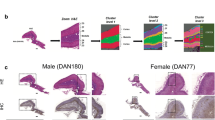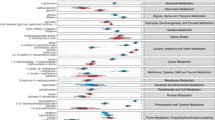Abstract
Recent advances in metabolomic technologies and methodologies have identified significant metabolites related to rare endocrine disease conditions of the adrenal gland (hyperaldosteronism, primary adrenal insufficiency), parathyroid (hypoparathyroidism), and cystic fibrosis. Metabolomic profiling combined with genomics is increasingly being employed for improving understanding, clinical diagnosis, and management of these clinically challenging conditions. Advances in gas and liquid chromatography combined with tandem mass spectrometry (GC/LC–MS/MS) techniques have improved the profiling of steroid metabolites. Significant alterations in levels of these metabolites demonstrate the potential to serve as specific markers of disease, help in their stratification, and contribute toward moving to personalized medicine.
Access this chapter
Tax calculation will be finalised at checkout
Purchases are for personal use only
Similar content being viewed by others
Abbreviations
- ATP1A1:
-
ATPase Na+/K + -transporting subunit alpha 1
- ATP2B3:
-
ATPase plasma membrane Ca2+ transporting 3
- CACNA1H:
-
Calcium voltage-gated channel subunit alpha 1 H
- CACNA1H:
-
Calcium voltage-gated channel subunit alpha 1 H
- CASR:
-
G protein-coupled calcium-sensing receptor
- CCND1/PRAD1:
-
Cyclin D1
- CDKN1C:
-
Cyclin-dependent kinase inhibitor 1C
- CFTR:
-
CF transmembrane conductance regulator
- CHD7:
-
Chromodomain helicase DNA binding protein 7
- CLCN2:
-
Chloride voltage-gated channel 2
- CSDE1:
-
Cold shock domain-containing E1
- CTNNB1:
-
Catenin beta 1
- CYP11B2:
-
Cytochrome P450 family 11 subfamily B member 2
- DAX-1 (NR0B1) SF-1:
-
Nuclear receptor subfamily 0 group B member 1
- DLST:
-
Dihydrolipoamide S-succinyltransferase
- FH:
-
Fumarate hydratase
- GATA3:
-
GATA binding protein 3
- GCM2:
-
Glial cells missing transcription factor 2
- GNA11:
-
G protein subunit alpha 11
- H3F3A:
-
H3.3 histone A
- HIF2A:
-
Hypoxia-inducible factor 1 subunit alpha
- HRAS:
-
HRas proto-oncogene, GTPase
- IDH:
-
Isocitrate dehydrogenase (NADP(+)) 1
- IRP1:
-
Iron regulatory protein
- KCNJ5:
-
Potassium inwardly rectifying channel subfamily J member 5
- MAML3:
-
Mastermind-like transcriptional coactivator 3
- MDH2:
-
Malate dehydrogenase 2
- NF1:
-
Neurofibromin 1
- NR5A1:
-
Nuclear receptor subfamily 5 group A member 1
- P450scc/CYP11A1:
-
Cytochrome P450 family 11 subfamily A member 1
- PHD1:
-
Prolyl hydroxylase 1
- POLE1:
-
DNA polymerase epsilon, catalytic subunit
- PTH:
-
Parathyroid hormone
- RET:
-
Ret proto-oncogene
- SAMD9:
-
Sterile alpha motif domain containing 9
- SDHx:
-
Succinate dehydrogenase complex iron-sulfur subunit B
- SEMA3E:
-
Semaphorin 3E
- SGPL1:
-
Sphingosine-1-phosphate lyase 1
- SLC25A11d:
-
Solute carrier family 25 member 13
- SOX3:
-
SRY-Box transcription factor 3
- TMEM127:
-
Transmembrane protein 127
- VHL/EPAS:
-
Von Hippel–Lindau tumor suppressor
References
Nieman LK, Ilias I. Evaluation and treatment of Cushing’s syndrome. Am J Med. 2005;118(12):1340–6.
Mourtzi N, et al. Unravelling the genetic basis of primary aldosteronism. Nutrients. 2021;13(3):875.
Young WF Jr. Diagnosis and treatment of primary aldosteronism: practical clinical perspectives. J Intern Med. 2019;285(2):126–48.
Monticone S, et al. GENETICS IN ENDOCRINOLOGY: the expanding genetic horizon of primary aldosteronism. Eur J Endocrinol. 2018;178(3):R101–11.
Azizan EA, et al. Somatic mutations in ATP1A1 and CACNA1D underlie a common subtype of adrenal hypertension. Nat Genet. 2013;45(9):1055–60.
Seidel E, Schewe J, Scholl UI. Genetic causes of primary aldosteronism. Exp Mol Med. 2019;51(11):1–12.
Funder JW, et al. The management of primary aldosteronism: case detection, diagnosis, and treatment: an endocrine society clinical practice guideline. J Clin Endocrinol Metab. 2016;101(5):1889–916.
Storbeck KH, et al. Steroid metabolome analysis in disorders of adrenal steroid biosynthesis and metabolism. Endocr Rev. 2019;40(6):1605–25.
Tokarz J, et al. Endocrinology meets metabolomics: achievements, pitfalls, and challenges. Trends Endocrinol Metab. 2017;28(10):705–21.
Hundemer GL, et al. Cardiometabolic outcomes and mortality in medically treated primary aldosteronism: a retrospective cohort study. Lancet Diabetes Endocrinol. 2018;6(1):51–9.
Hundemer GL, et al. Renal outcomes in medically and surgically treated primary aldosteronism. Hypertension. 2018;72(3):658–66.
Spyroglou A, et al. Transcriptomics, epigenetics, and metabolomics of primary aldosteronism. Cancers (Basel). 2021;13(21):5582.
Eisenhofer G, et al. Mass spectrometry-based adrenal and peripheral venous steroid profiling for subtyping primary aldosteronism. Clin Chem. 2016;62(3):514–24.
Murakami M, et al. In situ metabolomics of aldosterone-producing adenomas. JCI Insight. 2019;4(17):e130356.
De Sousa K, et al. Genetic, cellular, and molecular heterogeneity in adrenals with aldosterone-producing adenoma. Hypertension. 2020;75(4):1034–44.
van der Heijden C, et al. Vasculometabolic and inflammatory effects of aldosterone in obesity. J Clin Endocrinol Metab. 2020;105(8):2719.
Papathomas TG, Nose V. New and emerging biomarkers in endocrine pathology. Adv Anat Pathol. 2019;26(3):198–209.
Ulick S, Chu MD. Hypersecretion of a new corticosteroid, 18-hydroxycortisol in two types of adrenocortical hypertension. Clin Exp Hypertens A. 1982;4(9–10):1771–7.
Nakamura Y, et al. 18-oxocortisol measurement in adrenal vein sampling as a biomarker for subclassifying primary aldosteronism. J Clin Endocrinol Metab. 2011;96(8):E1272–8.
Mulatero P, et al. 18-hydroxycorticosterone, 18-hydroxycortisol, and 18-oxocortisol in the diagnosis of primary aldosteronism and its subtypes. J Clin Endocrinol Metab. 2012;97(3):881–9.
Williams TA, et al. Genotype-specific steroid profiles associated with aldosterone-producing adenomas. Hypertension. 2016;67(1):139–45.
Fluck CE. MECHANISMS IN ENDOCRINOLOGY: update on pathogenesis of primary adrenal insufficiency: beyond steroid enzyme deficiency and autoimmune adrenal destruction. Eur J Endocrinol. 2017;177(3):R99–R111.
Nowotny H, et al. Therapy options for adrenal insufficiency and recommendations for the management of adrenal crisis. Endocrine. 2021;71(3):586–94.
Espiard S, et al. Improved urinary cortisol metabolome in addison disease: a prospective trial of dual-release hydrocortisone. J Clin Endocrinol Metab. 2021;106(3):814–25.
Chantzichristos D, et al. Identification of human glucocorticoid response markers using integrated multi-omic analysis from a randomized crossover trial. elife. 2021;10:10.
Sorgdrager FJH, et al. Hydrocortisone affects fatigue and physical functioning through metabolism of tryptophan: a randomized controlled trial. J Clin Endocrinol Metab. 2018;103(9):3411–9.
Hescot S, et al. Prognosis of malignant pheochromocytoma and paraganglioma (MAPP-Prono study): a European network for the study of adrenal tumors retrospective study. J Clin Endocrinol Metab. 2019;104(6):2367–74.
Darr R, et al. Pheochromocytoma—update on disease management. Ther Adv Endocrinol Metab. 2012;3(1):11–26.
Erlic Z, et al. Metabolic impact of pheochromocytoma/paraganglioma: targeted metabolomics in patients before and after tumor removal. Eur J Endocrinol. 2019;181(6):647–57.
Neumann HPH, Young WF Jr, Eng C. Pheochromocytoma and paraganglioma. N Engl J Med. 2019;381(6):552–65.
Fishbein L, et al. Comprehensive molecular characterization of pheochromocytoma and paraganglioma. Cancer Cell. 2017;31(2):181–93.
Eijkelenkamp K, et al. Clinical implications of the oncometabolite succinate in SDHx-mutation carriers. Clin Genet. 2020;97(1):39–53.
Mercado-Asis LB, et al. Pheochromocytoma: a genetic and diagnostic update. Endocr Pract. 2018;24(1):78–90.
Lenders JW, et al. Pheochromocytoma and paraganglioma: an endocrine society clinical practice guideline. J Clin Endocrinol Metab. 2014;99(6):1915–42.
Richter S, et al. Krebs cycle metabolite profiling for identification and stratification of pheochromocytomas/paragangliomas due to succinate dehydrogenase deficiency. J Clin Endocrinol Metab. 2014;99(10):3903–11.
Dwight T, et al. Metabolomics in the diagnosis of pheochromocytoma and paraganglioma. Horm Metab Res. 2019;51(7):443–50.
Richter S, et al. Metabolome-guided genomics to identify pathogenic variants in isocitrate dehydrogenase, fumarate hydratase, and succinate dehydrogenase genes in pheochromocytoma and paraganglioma. Genet Med. 2019;21(3):705–17.
Lendvai N, et al. Succinate-to-fumarate ratio as a new metabolic marker to detect the presence of SDHB/D-related paraganglioma: initial experimental and ex vivo findings. Endocrinology. 2014;155(1):27–32.
Chae YC, et al. Landscape of the mitochondrial Hsp90 metabolome in tumours. Nat Commun. 2013;4:2139.
Jochmanova I, Pacak K. Pheochromocytoma: the first metabolic endocrine cancer. Clin Cancer Res. 2016;22(20):5001–11.
de Cubas AA, et al. DNA methylation profiling in pheochromocytoma and paraganglioma reveals diagnostic and prognostic markers. Clin Cancer Res. 2015;21(13):3020–30.
Imperiale A, et al. A new specific succinate-glutamate metabolomic hallmark in SDHx-related paragangliomas. PLoS One. 2013;8(11):e80539.
Li D, et al. Heterozygous mutations in TBX1 as a cause of isolated hypoparathyroidism. J Clin Endocrinol Metab. 2018;103(11):4023–32.
Gordon RJ, Levine MA. Genetic disorders of parathyroid development and function. Endocrinol Metab Clin N Am. 2018;47(4):809–23.
Paprocka J, et al. Neurological picture and 1H MRS in 4 children with hypoparathyroidism. Przegl Lek. 2005;62(7):680–4.
Liessi N, et al. Proteomics and metabolomics for cystic fibrosis research. Int J Mol Sci. 2020;21(15):5439.
Muhlebach MS, Sha W. Lessons learned from metabolomics in cystic fibrosis. Mol Cell Pediatr. 2015;2(1):9.
Al-Qahtani W, et al. Dried blood spot-based metabolomic profiling in adults with cystic fibrosis. J Proteome Res. 2020;19(6):2346–57.
Wetmore DR, et al. Metabolomic profiling reveals biochemical pathways and biomarkers associated with pathogenesis in cystic fibrosis cells. J Biol Chem. 2010;285(40):30516–22.
Masood A, et al. Distinctive metabolic profiles between cystic fibrosis mutational subclasses and lung function. Metabolomics. 2021;17(1):4.
Muhlebach MS, et al. Metabonomics reveals altered metabolites related to inflammation and energy utilization at recovery of cystic fibrosis lung exacerbation. Metabol Open. 2019;3:100010.
Alvarez JA, et al. Plasma metabolomics in adults with cystic fibrosis during a pulmonary exacerbation: a pilot randomized study of high-dose vitamin D3 administration. Metabolism. 2017;70:31–41.
Grasemann H, et al. Decreased systemic bioavailability of L-arginine in patients with cystic fibrosis. Respir Res. 2006;7:87.
Zardini Buzatto A, et al. Lipidome alterations induced by cystic fibrosis, CFTR mutation, and lung function. J Proteome Res. 2021;20(1):549–64.
Guerrera IC, et al. A novel lipidomic strategy reveals plasma phospholipid signatures associated with respiratory disease severity in cystic fibrosis patients. PLoS One. 2009;4(11):e7735.
Ollero M, et al. Plasma lipidomics reveals potential prognostic signatures within a cohort of cystic fibrosis patients. J Lipid Res. 2011;52(5):1011–22.
Grothe J, et al. Plasma phosphatidylcholine alterations in cystic fibrosis patients: impaired metabolism and correlation with lung function and inflammation. Cell Physiol Biochem. 2015;35(4):1437–53.
Neerincx AH, et al. Lumacaftor/ivacaftor changes the lung microbiome and metabolome in cystic fibrosis patients. ERJ Open Res. 2021;7(2):00731.
Macedo AN, et al. The sweat metabolome of screen-positive cystic fibrosis infants: revealing mechanisms beyond impaired chloride transport. ACS Cent Sci. 2017;3(8):904–13.
Esther CR Jr, et al. Metabolomic evaluation of neutrophilic airway inflammation in cystic fibrosis. Chest. 2015;148(2):507–15.
Innis SM, et al. Choline-related supplements improve abnormal plasma methionine-homocysteine metabolites and glutathione status in children with cystic fibrosis. Am J Clin Nutr. 2007;85(3):702–8.
Keller BO, Davidson AG, Innis SM. Phthalate metabolites in urine of CF patients are associated with use of enteric-coated pancreatic enzymes. Environ Toxicol Pharmacol. 2009;27(3):424–7.
Author information
Authors and Affiliations
Corresponding authors
Editor information
Editors and Affiliations
Rights and permissions
Copyright information
© 2023 The Author(s), under exclusive license to Springer Nature Singapore Pte Ltd.
About this chapter
Cite this chapter
Masood, A., Malkawi, A., Siaj, M., Abdel Rahman, A.M. (2023). Metabolomics and Genetics of Rare Endocrine Disease: Adrenal, Parathyroid Glands, and Cystic Fibrosis. In: Abdel Rahman, A.M. (eds) Clinical Metabolomics Applications in Genetic Diseases. Springer, Singapore. https://doi.org/10.1007/978-981-99-5162-8_9
Download citation
DOI: https://doi.org/10.1007/978-981-99-5162-8_9
Published:
Publisher Name: Springer, Singapore
Print ISBN: 978-981-99-5161-1
Online ISBN: 978-981-99-5162-8
eBook Packages: MedicineMedicine (R0)




